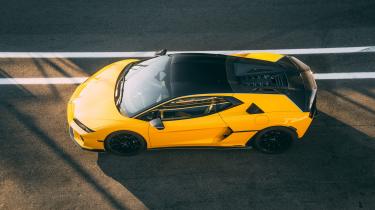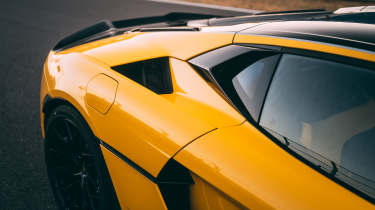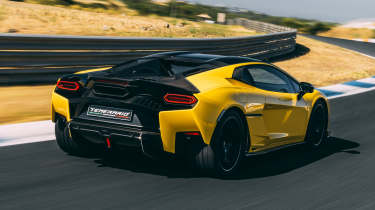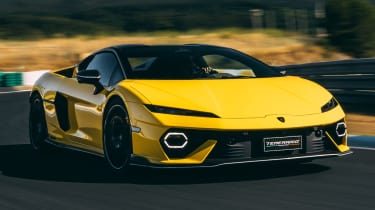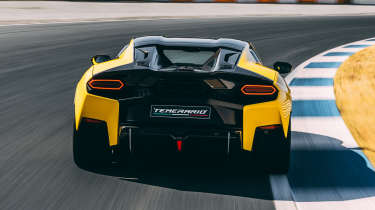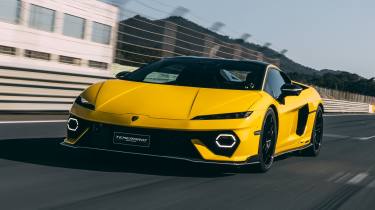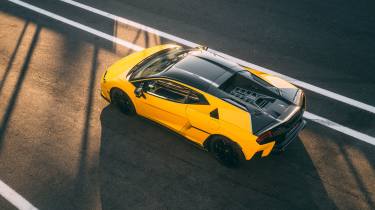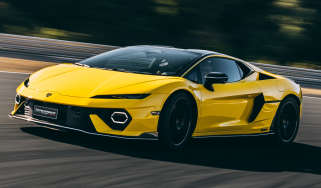Lamborghini Temerario 2025 review – 907bhp hybrid Huracán successor tested flat-out
It’s got a 10,000rpm V8 supported by a trio of electric motors, but does the tech dilute the Lambo soul?
This is nuts. We’ve been sitting in the new Lamborghini Temerario for barely two minutes and yet here we are, barrelling into a braking area at 190mph. It’s quite the introduction. One that highlights the raw speed of this ultra-techy 907bhp hybrid supercar, but also the absurd ease with which you can access and deploy its performance.
We’ve been waiting a while for this opportunity. Appetites were whetted by the initial reveal, in which details emerged of an all-new hybridised 10,000rpm twin-turbo V8 designed and built in-house at Lambo’s Sant’Agata factory; the long-awaited Huracán replacement didn’t so much promise to take the fight to Ferrari as launch a full-scale assault on Maranello.
As with the Revuelto back in 2023, our first drive of the Temerario is on track only, the company awaiting the formality of final homologation once again being cited as the reason we can’t yet drive it on the road. It’s frustrating, for it means we can’t give you a complete assessment of the car, but as first tastes go it’s a hundred times better than the dreaded dynamic passenger ride.
We’re at Estoril in Portugal. Resolutely old-school with little in the way of run-off, this legendary circuit is a bold place to let the world’s motoring media and internet influencers loose in your brand-new bullet-fast, £260k challenger to the Ferrari 296 GTB and McLaren 750S.
More reviews
Our first track session is an intense start to what transpires to be a relentless immersion in all things Temerario. Many of Lambo’s big guns are here, including president and CEO Stephan Winkelmann, Centro Stile design boss Mitja Borkert, chief technical officer Rouven Mohr and Temerario line director Paolo Racchetti.
Engine, gearbox and technical highlights
It’s fair to say the Huracán was less than perfect when it was launched in 2014. The seats were instruments of torture and the dynamics were somewhat unresolved, in so much as there wasn’t much in the way of feel and the balance was more nose-led than ideal. The equivalent Audi R8 was the sweeter drive. Still, there was no argument about the way it looked. Nor the way it sounded, thanks to its 5.2-litre V10, which always seemed to have a bit more fire in its belly than that of its milder-mannered oppo from Böllinger Höfe.
As it matured, so the Huracán found its groove. By the time the Evo, STO and Tecnica were introduced it was amongst the finest and most evocative supercars money could buy. Finishing on such a high meant Lamborghini was faced with the toughest of acts to follow. Throw in increasingly restrictive environmental regulations, which mandated the new car would have to feature a degree of electrification, and the job of creating a suitably special replacement must have seemed almost insurmountable.
They’ve been busy, for the Temerario is new from nose to tail. A fresh look brings increased aero efficiency, while a new aluminium monocoque saves weight, increases rigidity and provides more occupant space. The blockbusting V8 is mated to a new eight-speed DCT gearbox and electric front axle, which features a pair of e-motors for trick torque vectoring.
There’s a third motor sandwiched between the engine and gearbox (the ’box, motors, battery and associated hybrid gubbins are all shared with the Revuelto). Mounting the new DCT transversely behind the V8 creates space in the central tunnel to package the lithium-ion battery pack. Of limited capacity but quick to charge and discharge, the battery is recharged during regenerative braking via the front axle or directly from the V8. It can also be charged from an ordinary domestic supply in as little as 30 minutes, though EV-only range is limited to six miles.Just as significantly, there’s also a new philosophy around the Temerario’s chassis dynamics and driving character.
It’s long been the case that Lamborghini reserves the scissor-doored shock and awe for its V12 flagships. This remains the case with the Temerario, which keeps conventional doors as per Gallardo and Huracán. Overall it’s an elegant design with just the right amount of drama. Front, rear and side profiles are all head-swivellingly compelling.
My favourite area is the extreme cutaways in the rear bodywork revealing the full width of the 325/30 ZR21 tyres, but there are plenty of other details to pore over. As the assembled group of Temerarios illustrates, it has a knack of looking equally good in garish or subdued colours. With Lamborghini offering 400 hues, there’s certainly no lack of choice.
The shape is clean, with clever use of airflow over, under and through areas of the bodywork to generate downforce (increased by more than 100 per cent at the rear compared with the Huracán), feed cooling air to where it’s needed and extract hot air from the radiators, brakes and engine bay.
There’s also an Alleggerita package, which saves weight and adds downforce (a further 55 per cent gain at the rear) via a suite of replacement carbon panels comprising front splitter, floor, side skirts, engine cover and a more pronounced rear ducktail. It also adds satin-finish interior carbonfibre trim and a pair of lightweight sports seats. Combined, these items save a little over 12.5kg. It’ll also lighten your wallet, to the tune of £37,200. A further 12.5kg can be saved by opting for carbonfibre wheels and a titanium exhaust.
Structurally the Temerario sticks with aluminium, finding significant improvements in weight efficiency and torsional rigidity (plus 20 per cent) over the previous-generation spaceframe thanks to new high-strength alloys, hydroformed extrusions and hollow castings. It’s also less complex, with a 50 per cent reduction in the number of components and 80 per cent less weld-bead length. It’s clever stuff.
Despite saving weight with the smarter next-gen alloy frame, at 1690kg without fluids the Temerario is 250kg heavier than the car it replaces. That’s a hefty penalty, but one mitigated by clever placement of the major masses and even smarter use of the twin motor front e-axle and the third motor, which joins forces with the V8 to drive the rear axle.
> Best supercars 2025 – our favourite show-stopping driving machines
Like its big brother the Revuelto, pressing the big red button on the centre tunnel doesn’t so much start the Temerario up as switch it on, with the ICE component of the powertrain remaining silent until you switch from EV-only Citta through Strada (the mildest of the hybrid modes) to Sport.
Performance, ride and handling
Let loose we most certainly are. Tucked in the wake of an instructor-driven lead car with a little over 300kph (186mph) showing on the dash display, we plunge into the downhill braking zone for Estoril’s second-gear Turn 1. It’s serious speed in any car, let alone the new baby of Lamborghini’s supercar range.
Circuit driving isn’t intended to demonstrate refinement, but before we’ve exited the pitlane it’s obvious the Temerario has been developed and honed to be as approachable and user-friendly as possible. Literally anyone would feel happy driving it. As with big brother Revuelto, pressing the red button on the centre tunnel doesn’t so much start the Temerario up as switch it on, with the ICE component of the powertrain remaining silent until you switch from EV-only Citta through Strada (the mildest of the hybrid modes) to Sport.
> When a Lamborghini press launch turned into a 25 hour fever dream
Even through the muffling effects of a crash helmet it’s clear the new L411 V8 makes a typical flat-plane-crank sound. And you only need to drive 50 metres to find the steering, gearshift and brakes have a uniform lightness of touch. It’s all very calm and entirely unintimidating. Which I have to say is a little bit unexpected and yes, somewhat disappointing given this is a 900-plus bhp, 213mph Lamborghini. Low-speed drama is in short supply.
Of course, the old V10 is a tough act to follow. Big capacity. Lots of cylinders. No turbos. And produced in an era when manufacturers had the freedom to give their supercars a proper voice. Lambo knew it had to do something extreme for its replacement, hence the wild 10,000rpm red line. It’s hard to imagine what was required to get an engine like this to pass VW Group’s notoriously tough durability tests. But pass it did.
It’s a curious engine. Its character and delivery are shaped partly by hybrid assistance and a fiendishly complex blend of turbo boost and battery shove for effortless flex and apparently limitless revs. Out on track it’s this mash-up of small-capacity screamer and big-capacity slugger (peak torque is 538lb ft) that wrong-foots you. Or at least forces you to really think about what it is that characterises the Temerario when you floor the throttle.
It has brilliant response. Not just when you make a sustained squeeze into the gas, but in those critical moments when you’re modulating the throttle; never fully on or fully off but working in the transient zone where you want the finest possible control and minimal latency so you can find the limit of traction and play with the balance of the car.
> Lamborghini Huracán Tecnica review – a supercar of the old-school
That’s very hard to achieve in a turbocharged engine. The V8’s appetite for revs is prodigious, as is the pace with which it works to that lofty red line. It pulls and pulls and pulls, rapidly in the lower gears where you get maximum assistance from the batteries, but in fourth gear and beyond the Temerario has a relentlessness that takes your breath away.
Clever boost management ensures it sustains peak power between 9000 and 9750rpm, so there’s no sense of tailing off. If you consider the engineering challenges Lamborghini had to overcome it’s hard not to be hugely impressed by the efficacy of this new turbocharged hybrid V8.
As for the emotion? Well, the performance it unleashes certainly gets your heart pumping, but I have to say there’s not a great deal of joy to be had from the sound it makes. You certainly wouldn’t nip out to your garage and start it up for the hell of it. That’s not Lambo’s fault – all the ‘proper’ manufacturers are in the same boat, but aftermarket exhaust makers must be rubbing their hands.
Without its hybrid-related components the new transversely-mounted eight-speed ’box is lighter than the Huracán’s seven-speed unit. It also delivers faster shifts, and in Corsa mode they’re clean and punchy. Not as clinical as a Porsche PDK’s but a little sharper-feeling than the Ferrari 296’s.
Road driving will reveal how it feels in the less aggressive modes and in part-throttle driving, but it’s clear Lamborghini has worked very hard to create a shift character that’s precise but with just enough feeling of inertia and torque push to give you a positive sense of completing the upshift. It’s minimal compared to the whiplash-inducing upshifts of Lambo’s old ASM single-clutch gearboxes, but it brings just enough character without feeling contrived.
Much like the Revuelto, the Temerario confounds the scales by behaving like a smaller and more wieldy car than the one it replaces. Though it is resolutely not a track-biased car, the way it performs around Estoril demonstrates the fundamental soundness of the set-up. Whether it’s on standard Bridgestone Potenza Sport tyres or stickier Potenza Race, it has a neutral to oversteer balance that feels precise but playful, nicely intuitive and naturally rear-wheel drive.
We complete our first laps in a regular example on Potenza Sports and the following two sessions in an Alleggerita on Potenza Race tyres. Both tyre options carry Lambo-specific ‘L’ marks denoting bespoke development. The Race tyre is interesting because Bridgestone and Lamborghini chose to yield a little in terms of outright one-lap performance compared to a Michelin Cup 2 R in favour of more consistent performance and reduced wear. We didn’t time our laps at Estoril, but they felt super-consistent from stint to stint across the day.
The brakes are immensely impressive, with a reassuringly firm and consistent pedal. That monster braking zone into Turn 1 never troubled them for outright stopping power and fade was non-existent. Just as impressive is the way you can modulate the braking pressure. Huracáns always had somewhat tricky brakes, so the Temerario’s pedal feel and response bodes well for the more nuanced demands of road driving.
There’s some very clever stuff going on with the calibration of the dynamic modes, especially when it comes to how the front torque vectoring and rear e-motor are used. In Corsa mode (with ESC on) the front axle is used earlier in the corner-exit phase to maximise stability and traction for the cleanest and quickest run onto the straight.
Knock it back to Sport and you immediately feel the Temerario become more playful, which requires more input in terms of countersteering and throttle applications. This is because the rear e-motor makes its contribution earlier in the corner and fractionally ahead of the front axle, so you get that extra rotational energy for maximum ‘fun-to-drive’, which from what I can gather is a de-Deutsche-ified replacement for ‘sportiv Faszination’. It is indeed a brave new world.
You can disable the ESC by switching to Corsa Plus mode, but sadly we didn’t get the opportunity to try this. However, we did have the chance to try the Drift Mode. I have to say that in general I’m not a fan of these big-slip-angle ESC modes because they never feel that natural. Instead they require you to suspend your instincts in favour of an admittedly sophisticated algorithm that takes readings from throttle, steering, yaw and speed sensors to predict your inputs.
The Temerario’s three-stage system is little different in this respect, though once you find the knack and drive by rote it does allow big, smoky slides. Indeed, it’ll let you spin if you’re too greedy on the power and/or too slow on the steering.
Stay within the limits of the system and it does a convincing job, but start to explore the outer reaches of its prescribed limits and you can feel the electronics quietly taking over. Initiate slides with more aggressive inputs and it’s less likely to play ball and will sometimes actively work against you. It’s a good training tool that opens up the opportunity of oversteer with varying degrees of safety for less experienced hands, but if you know what you’re doing you’ll prefer to go with ESC Off so you can truly feel – and trust – the car.
Its lightness of touch will divide opinion. Personally, I would like the steering to have more meat to it. Not for the sake of machismo – excessive control weights are dumb – but because it would add an appropriate level of physical effort and connection for what is an extremely potent supercar.
As it stands, the steering is too light and its feedback so finely filtered it’s all a bit too clean. Perhaps that’s inevitable when so much of the car relies on a forensic level of electronic calibration and system integration. It’s certainly hard to imagine how engineers might introduce a bit of analogue grit without it feeling horribly contrived, but that’s what it’s missing.
Interior and tech
What you notice immediately upon swinging open the driver’s door is the new structure’s narrower sill and greater cabin space, with headroom increased by 34mm and legroom by 46mm. Despite the e-axle there’s sufficient space in the frunk to take two carry-on cases, with additional space behind the seats.
Such practicalities might sound at odds with Lambo’s hardcore image, but these cars are covering proper miles. Late-model Huracáns were driven around 5000 miles per annum on average and Lamborghini expects Temerario owners to exceed this, so useability is increasingly important.
Verdict, price and rivals
As you’re probably gathering by now, the Temerario is an intriguing but also rather contradictory machine. In some regards it nails the brief, sharp looks and blistering performance being exactly what you want from a Lamborghini. The way the hybrid technology has been applied makes it feel absolutely up-to-the-minute and endows it with an impressive breadth of dynamic accessibility and capability, not to mention refinement. A Huracán would feel long in the tooth by comparison.
On the positive side, this track drive suggests the Temerario has the temperament to shine on the road, though I do wonder whether the lauded 10,000rpm red line will be largely redundant when there’s so much low and mid-range punch. It certainly isn’t alone in this regard: a 750S or 296 GTB are both madly fast, but as the McLaren is more feelsome and the Ferrari a little more soulful, if the Lambo’s hard-won USP is tricky to access on the road, chasing such an extreme and emotive red line could be seen as a trivial pursuit. Pointless, even, if you’re not going to take your Temerario on track.
What we mustn’t forget is that this is the starting point. It seems churlish to say so mere moments after it has been launched, but there will undoubtedly be more Temerario derivatives in years to come. Some of those will be more hardcore, in the vein of the Huracán Performante and STO. Output-wise there’s apparently some headroom in the powertrain, but even if you stuck with 907bhp there’s clearly scope to put some sharper edges on the currently silky smooth power and torque curves.
Unsurprisingly I couldn’t get anyone to bite on my admittedly non-engineery suggestion that perhaps it might be possible to drop the front e-axle and send all the battery power to the rear electric motor for a lighter, purer and altogether hairier rear-drive Temerario. Even if you just applied a more aggressive chassis set-up and dialled in a bit more steering effort and connection the Temerario would find a welcome edge.
I’ll be the first to admit that I am not in the market for a £300k supercar, but I’ve driven enough of them to know that the Temerario’s weakness is in being too polite. It’s almost as though it thinks it’s a next-gen Audi R8. Not in looks, but certainly in deeds. That’s not meant as an insult, but hopefully frames the marked shift in character compared with the gnarly old Huracán.
It certainly isn't cheap. At base the Temerario will cost £259,567 but that's before the £37,200 Alleggerita pack and before the £21k carbonfibre wheels. Most cars, with a splash of Ad Personam and a few choice options, won't reach customers for less than £300k.
Specs
| Engine | V8, 3995cc, twin-turbo, plus three 110kW e-motors |
|---|---|
| Power | 907bhp (combined) |
| Torque | 538lb ft (ICE only) @ 4000-7000rpm |
| Weight | 1690kg (dry) (545bhp/ton) |
| Tyres | Bridgestone Potenza Sport |
| 0-62mph | 2.7sec |
| Top speed | 213mph |
| Basic price | £259,567 |

